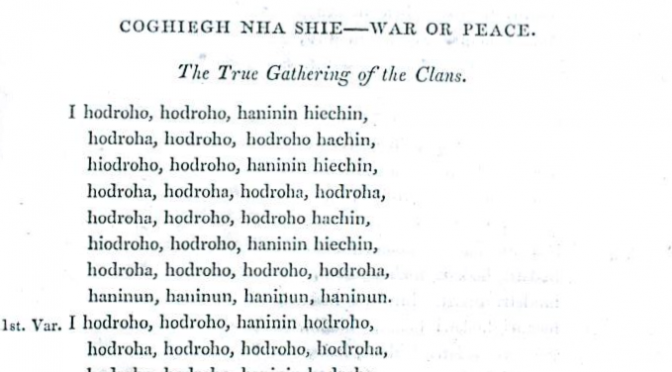I am working on the pìobaireachd or ceòl mór, Cogadh no Sith, for this coming Wednesday’s lunchtime concert in St Andrews.
My idea is that this grand geometrical composition can stand as a kind of proxy for the lost medieval Gaelic harp repertory, which would have been played on the Queen Mary harp in the great hall at Finlaggan in the 15th Century for the Lords of the Isles.
I latched on to the idea of using Cogadh no Sith as part of my project to re-imagine the music of the Lords of the Isles – Ceol Rìgh Innse Gall – after reading a little snippet of lore associated with the tune:
Coghiegh na Shie (War or Peace).—Played by pipers of the different clans who held of the lords of the Isles (before the forfeiture of John, last Lord of the Isles) during their independence of the Crown of Scotland, and also to bring the different clans to battle when the Scots were to cross the Border to England.1
This information came from an 18th century piper, Iain Dubh MacCruimein (c.1731 – c.1822), grandson of the famous Pàdruig Òg, hereditary piper to MacLeod. He supplied oral notation of the tune to Macleod of Gesto, who published it in 1828.2
Of course, traditionary lore like this is not historically reliable, but I was interested in the age and authority of this tradition.
John Purser, at his talk Pìobaireachd – what it might mean for the clarsach in Edinburgh in April 2013, suggested that Cogadh no Sith would be a good piece to try on the harp. At that time I had not really looked at it.
![Patrick MacDonald, A Collection of Highland Vocal Airs, Edinburgh [1784]](https://simonchadwick.net/wp-content/uploads/2016/07/PmcD-224x300.png)
’S coma leam, ’s coma leam cogadh no sith; Marbhar ’sa cogadh, no crochar ’san t-sith mi.
(Alike to me, alike to me, war or peace; Killed in the war, or hanged in the peace).
I also listened to Allan MacDonald and Barnaby Brown in conversation with John MacInnes on the pronounciation of the title.
When I did finally start working on the tune, it struck me that it was very geometrically structured, and I found that it naturally invited the composition or improvisation of new variations modeled on those in the Robert ap Huw manuscript of medieval Welsh harp music. I would consider this kind of geometric formality a sign of the antiquity of a tune: I think that these are very ancient compositional principles, and the more strict and yet elaborately subtle a tune is, the more I think it shows us the nature of the really old strands of the tradition.
So, whether or not the tune really goes back to medieval times, I think it works very well as a basis for re-imagining the medieval sound of the Queen Mary harp in performance.

I’m playing the tune high on the harp, and I have composed a set of six variations inspired by the medieval Welsh tune, Caniad San Silin. I played Cogadh no Sith with these six variations at the concert I did with Gillebrìde MacMillan at Armadale in 2014. This version runs to about 15 minutes.
Next week I intend to extend it to half an hour by getting more variations up and running. When I tried this two years ago for my St Andrews concert I played a set of pibroch-style variations, but I don’t now remember how many or exactly what! I like the idea of not fixing the sequence or the nature of the variations, because I am very interested in the idea of improvised variation sets, but on the other hand I do need to have some idea of where I am going. So I have been experimenting with possibilities.
On the one hand there is the attraction of a strictly regular and geometric scheme as shown in Caniad San Silin, with the variations grouped in threes, repeating with slight changes to give layered fractal-style structures. I can get this working with my first six variations here, with three different motifs that can be repeated a 3rd higher to generate the fourth to sixth variations.
However the pibroch style variations I am coming up with break the pattern; they have a much more lyrical feeling to them, encouraging me to swap down an octave and experiment with the bass register of the harp. Some of them are seeming to invite triplings as well as doublings.
I am wondering if I might imagine 24 cycles, organised asymmetrically into motions of different lengths, with six ap-Huw style motions each of two cycles (singling and doubling), but four pibroch-style motions each having three cycles (singling, doubling and tripling).
Or I might just play and see what happens, ending up with an odd number of cycles and motions.
I plan to try videoing the concert so you may have a chance to see what the result is, if you are unable to get to St Andrews next Wednesday lunchtime!
References
- The Celtic Magazine, vol VIII, no. XCIII, July 1883, p.434
- A Collection of Piobaireachd or Pipe Tunes, as verbally taught by the McCrummen pipers in the Isle of Skye, to their apprentices… Edinburgh, 1828.

